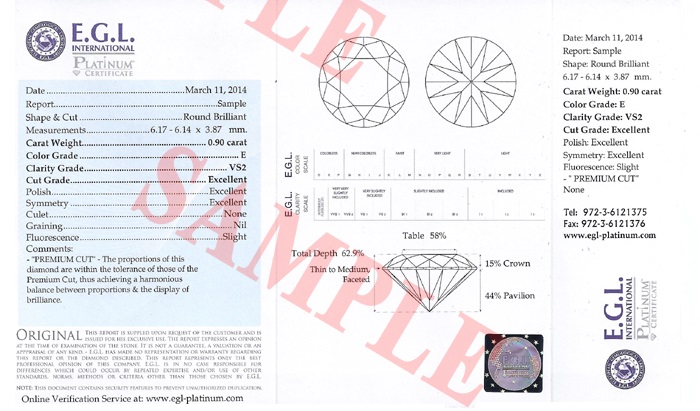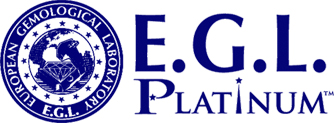Diamond Education
EGL Certification
In the shimmering world of diamonds, the provenance, cut, clarity, and certification of the stone define not just its beauty, but its value and trustworthiness. Among the myriad certifying entities, the European Gemological Laboratories (EGL) has remained a topic of both reverence and controversy within the diamond trade. With a history that intermingles innovation with disputes, understanding EGL is more than just comprehending its certification standards. It's about delving into its transformation over the years, the autonomy of its various labs, and the implications of its past discrepancies on today's market. In this comprehensive guide, we journey through EGL's intricate tapestry, unraveling its essence, and examining its standing in the present diamond landscape.
Summary:
- Historical Overview
- Controversies and Rebranding
- Grading Parameters and Certification Process of EGL
- EGL USA: An Unfair Victim?
- Services Offered by EGL USA
- EGL Platinum: A New Era?
Historical Overview of EGL Diamond Certification
Early Beginnings
EGL's initiation in Belgium was no coincidence. Antwerp, Belgium, had long been recognized as the 'diamond capital of the world,' with traders, polishers, and buyers congregating in this city for diamond dealings. As the demand for certified diamonds grew during the mid-to-late 20th century, EGL positioned itself as a forerunner in the field, leveraging its location and connections to provide reliable and efficient certification services.

Global Expansion
It wasn't long before EGL began expanding its services beyond Europe. Recognizing the burgeoning diamond markets in the US, South Africa, Israel, and India, EGL established independent franchises in these regions during the 1980s and 1990s. Each of these franchises operated with a level of autonomy, leading to variations in grading standards and practices, a fact that would later become a point of contention within the industry.
Technological Advancements
Being at the forefront of diamond certification, EGL was also one of the pioneers in embracing technological innovations to enhance its grading processes. From advanced spectroscopic analysis to sophisticated imaging systems, the lab continuously updated its arsenal, striving to provide more accurate and comprehensive certification reports.
Controversies and Rebranding
The late 20th and early 21st century saw EGL facing criticism for inconsistent grading standards among its independent franchises. While some branches maintained strict grading parameters, others were perceived as lenient. This discrepancy, coupled with market competition and rising consumer awareness, led to a period of introspection for EGL. Many branches underwent rigorous internal reviews and reforms, focusing on standardization and transparency to restore faith in their certification processes.
In conclusion, the evolution of EGL is a tale of ambition, innovation, challenges, and adaptation. From its strategic beginnings in Antwerp to its worldwide presence today, the lab's journey offers invaluable insights into the ever-changing landscape of diamond certification.
Grading Parameters and Certification Process of EGL
Understanding the 4Cs
Central to any diamond certification is the 4Cs: Cut, Color, Clarity, and Carat weight.
Cut: Refers to how well a diamond has been shaped and faceted. The quality of the cut affects the diamond's brilliance and sparkle.
Color: Measures the diamond's hue on a scale from D (colorless) to Z (light yellow or brown). The closer to colorless a diamond is, the rarer and more valuable it becomes.
Clarity: Evaluates the presence of internal or external flaws, known as inclusions and blemishes. Diamonds with the least and smallest inclusions are the most desired.
Carat Weight: Denotes the size of the diamond. One carat is equivalent to 0.2 grams.
EGL's Approach to Grading

EGL's grading system, while rooted in the 4Cs, encompasses other factors that provide a holistic evaluation of the diamond. The lab is known for its meticulous approach and has established some unique grading parameters:
Fluorescence: While not a part of the traditional 4Cs, EGL places importance on grading a diamond's fluorescence, which refers to how it reacts under ultraviolet light. Diamonds with strong fluorescence might appear slightly cloudy under natural light.
Finish: This examines the quality of a diamond's polish and the symmetry of its facets.
Proportions: EGL assesses how proportionate the facets of the diamond are, influencing its overall appearance and brilliance.
Technological Assistance
Modern diamond grading at EGL employs state-of-the-art equipment to ensure precise evaluation. Technologies such as spectrometry, microscopy, and high-definition imaging systems play an integral role in the process. These tools provide graders with comprehensive data, allowing for more consistent and accurate grading.
Certification Documentation
Upon completion of the grading process, EGL provides a certification report for each diamond. This document validates the diamond's attributes, including its 4Cs, fluorescence, finish, and proportions. Along with the grade, the certificate typically contains a plotted diagram of the diamond, highlighting any inclusions or blemishes.
EGL's rigorous certification process, combined with its innovative grading parameters, establishes it as a trusted entity in the world of diamonds. Whether for traders or end-consumers, an EGL certification provides an assurance of quality, authenticity, and value.
EGL USA: An Unfair Victim?
EGL USA is a distinct entity, often misunderstood due to the complexities of the diamond industry's grading landscape. The controversies surrounding certain EGL branches, particularly those outside of North America, have inadvertently cast shadows on EGL USA, raising questions about the fairness of these perceptions.

Distinct Identity and Operations
EGL USA operates autonomously from other EGL entities, with its methodologies, technologies, and personnel. The lab emphasizes its adherence to strict grading standards and has continuously worked to distance itself from controversies tied to other EGL labs. Its commitment to accuracy and transparency is evident in its grading processes and consumer interactions.
Unfortunate Name Association
The challenges for EGL USA primarily stem from its shared name with other EGL branches. Despite the variations in grading standards among the different labs, to the untrained eye or uninformed consumer, the name "EGL" stands as a monolithic entity. As a result, the actions or shortcomings of one branch can unjustly affect the reputation of others.
Efforts to Rebuild Trust
EGL USA has made significant strides in rebuilding trust within the industry and among consumers. By prioritizing education, the lab has undertaken initiatives to inform the public and traders about the differences between EGL USA and other EGL entities. Through open forums, seminars, and transparent reporting, the organization aims to dispel misconceptions.
The Role of the Broader Industry
It's essential for industry stakeholders, including traders, jewelers, and other certification labs, to recognize the distinct identity of EGL USA. Generalizations can harm the industry's integrity and lead to unwarranted skepticism among consumers. By promoting accurate information and acknowledging the lab's efforts to maintain high standards, the industry can ensure that EGL USA is evaluated on its merit, not on associations.
In conclusion, while EGL USA has faced challenges due to its shared name and the resulting associations, it's crucial to separate the lab from the controversies of its counterparts. With its dedication to rigorous grading and consumer education, EGL USA stands as a testament to the pursuit of excellence and transparency in the diamond industry.
Services Offered by EGL USA
EGL USA is not just a diamond grading lab; its array of services reflects its comprehensive approach to gemology and its commitment to providing robust resources for both industry professionals and consumers. From the intricacies of diamond grading to the vast world of colored gemstones, EGL USA offers a diversified portfolio of services, ensuring its clientele receives expertise and support for their varied needs.
Diamond Grading Reports
EGL USA's cornerstone service is its diamond grading reports. Using state-of-the-art technology and expertise, the lab provides detailed assessments of diamonds, considering aspects like:
Carat weight
Color grade
Clarity grade
Cut grade
Each diamond grading report is a testament to EGL USA's meticulous approach and dedication to accuracy.
Colored Gemstone Reports
Beyond diamonds, EGL USA offers grading services for colored gemstones. This service is vital for stones like sapphires, rubies, emeralds, and many others.
Each gemstone is evaluated for:
Origin
Treatment (if any)
Color
Clarity
Jewelry Analysis
For those with set jewelry pieces, EGL USA provides a comprehensive jewelry analysis service. This includes evaluating the piece as a whole, grading the stones within the setting, and appraising the metal's value.
Education and Training
EGL USA understands the importance of industry education. As such, they offer courses, workshops, and seminars aimed at training the next generation of gemologists and providing ongoing education for seasoned professionals.
Research and Development
In the ever-evolving world of gemology, EGL USA stays at the forefront through its commitment to research and development. Their team regularly explores advancements in grading technology, detection of treatments, and new gemstone sources.
Laser Inscription Services
To ensure a diamond's identity and security, EGL USA provides laser inscription services. This process involves inscribing a diamond's girdle with its unique grading report number, ensuring its traceability and authenticity.
Consumer Consultation and Verification Services
Understanding the need for consumer confidence, EGL USA offers consultation services, allowing consumers to verify grading reports, seek advice, and get clarifications on their purchased gemstones and jewelry.
In sum, EGL USA stands as a multifaceted institution in the gemological world. Their breadth of services showcases their dedication to excellence, innovation, and consumer trust, making them a valuable asset in the realm of gemstone assessment and education.
EGL Platinum: A New Era?
In the ever-competitive realm of gemology, the introduction of EGL Platinum marked a defining moment. It wasn't just a new branding strategy; it symbolized a fresh commitment to excellence, transparency, and innovation.

Emphasis on Modern Technology
EGL Platinum emerged with a clear focus on utilizing the latest advancements in gemological technology. By investing in state-of-the-art equipment, the lab ensured that grading was not only accurate but also consistent across the board.
Enhanced Transparency
With EGL Platinum, there was a notable emphasis on offering greater transparency in its grading processes. Detailed documentation, clear communication channels, and open discourse with clients ensured that every graded stone had a story that could be tracked and verified.
Consumer-Centric Approach
Understanding the contemporary consumer's needs, EGL Platinum sought to bridge the gap between complex gemological jargon and consumer understanding. By simplifying reports, offering consultation services, and prioritizing client education, EGL Platinum aimed to empower every buyer in the gemstone marketplace.
International Collaboration
In an age where global collaboration is key, EGL Platinum looked beyond borders. Collaborative efforts with other international labs, sharing of research and data, and a united approach to grading standards marked a new direction toward global consistency and credibility.
Conclusion
The intricate world of diamond grading is a rich tapestry woven with tradition, innovation, and integrity. While institutions like EGL USA have made indelible marks in pioneering certain approaches, the story of EGL International serves as a compelling reminder of the critical importance of consistency and trustworthiness in this domain.
EGL International, in its prime, was a preferred choice for many. However, concerns over its grading practices cast a spotlight on the vital role of transparency and accuracy in the industry. As we traverse the sparkling lanes of the diamond marketplace, the enduring reputations of labs like the International Gemological Institute (IGI) for lab-grown diamonds and the Gemological Institute of America (GIA) for natural diamonds serve as trusty beacons. These institutions have set gold standards, reassuring us about the genuine quality and value of the diamonds we cherish.
